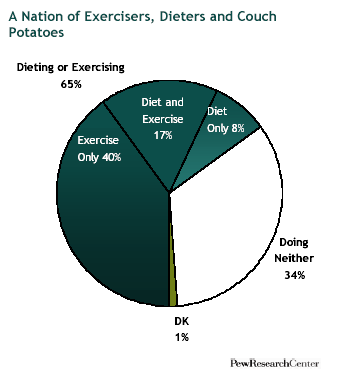
At a time when the nation’s waistline has expanded to record girth, about two-thirds (65%) of American adults are either dieting, exercising or doing both. But by their own reckoning, they don’t have much to show for their efforts.
A quarter of all adults are currently on a diet, but, on average, the dieters are 29 pounds heavier than they would like to be. Those adults who are not dieting, by contrast, are 12 pounds heavier than they would like to be.
Nearly six-in-ten (57%) adults report that they do some kind of exercise program to keep fit. But among these regular exercisers, about two-thirds (65%) report that they aren’t getting as much exercise as they should. And even though exercisers are closer to their ideal weight than are the dieters, they’re still not hitting the mark. Exercisers, on average, would like to be 14 pounds lighter than they are.
These findings are from a new Pew Research Center nationwide survey which also finds that Americans consider lack of exercise and lack of will power about eating to be the two most important reasons that many Americans are very overweight.
Key findings include:
- About a third (34%) of Americans are neither exercising nor dieting; 17% are doing both; 8% are dieting but not exercising; and 40% are exercising but not dieting. Those both dieting and exercising place themselves an average of 27 pounds over their ideal weight. Those doing neither put themselves 16 pounds over their ideal. (We defined dieters as those who report that they are currently trying to lose weight through some kind of special effort and exercisers as those who report that they take part in an exercise program to keep physically fit, apart from normal daily activities.)
- Among those who consider themselves overweight, 47% are currently dieting, and 75% say they have dieted in the past. About half (53%) of the self-described overweight are exercising.
- On average, Americans would like to be 16 pounds thinner than they are. Women would like to lose more weight than men; the average woman says she is 18 pounds above her ideal weight, while the average man says he is 14 pounds above his ideal weight.
- There is virtual consensus among Americans that it is hard for the very overweight to lose pounds; 93% of all adults say it is either hard or very hard. Dieters are even more inclined than non-dieters to say it is very hard to lose weight— a perception that may grow out of their own experience. Of those currently dieting, 83% have dieted in the past.
- About four-in-ten (42%) Americans report that they worry about their weight. About three quarters (73%) of dieters say they worry about their weight, as do 45% of exercisers.
Who’s on a diet?
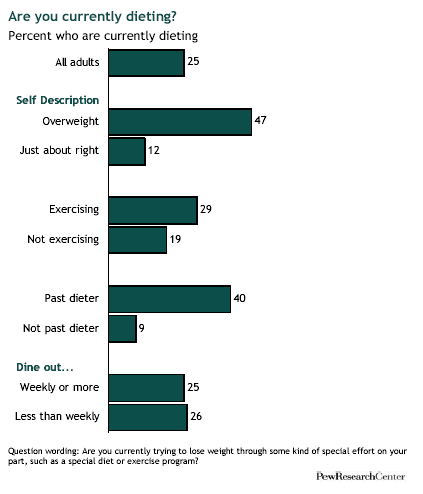
A quarter of Americans say that they are currently making a special effort to lose weight. More women than men are dieting. Among those over age 50, however, men and women are about equally likely to be dieting. Dieting does not vary significantly by education or income levels. Blacks, whites, and Hispanics are all about equally likely to be dieting.
Not surprisingly, those who consider themselves “overweight” are more likely to be dieting than those who think of themselves as “just about the right weight.” Almost half (47%) of those who consider themselves overweight are dieting; whereas just 12% of those who consider their weight about right are dieting. Dieting does not appear to be related to dining out or eating at home. Those eating at least weekly at restaurants are just as likely to be dieting as those who go out for a meal less frequently.
About two thirds (67%) of people on a diet also take part in some kind of exercise program.
Been there, done that.
About half (52%) of all Americans say they lost weight through some kind of diet in the past. More women than men have ever dieted and people in the middle adult years (ages 30 to 64) are more likely to have dieted than either younger (ages 18 to 29) or older (65 and above) adults.
The overweight are more likely to have dieted than those who are about right on the scale. Those who worry about their weight are also more likely to have dieted.
In spite of some research reports which highlight the low probabilities of maintaining weight loss over time, 74% of those who say they’ve dieted in the past (defined as having lost at least five pounds through some sort of special effort) also say that they kept the weight off for at least one year. Whether or not they maintained that weight loss, past dieters are more likely than newbies to be dieting now. Four-in-ten of those who’ve lost weight in the past are currently dieting. Just 9% of those who’ve never lost weight through some kind of special effort are currently dieting.
Who’s worrying about their weight?
About four-in-ten (42%) report that they worry about their weight all or some of the time. Women (51%) worry more than men (32%) about weight. More of those in their middle adult years worry about their weight than do either younger (ages 18 to 29) or older (ages 65 and above) adults. Worrying about weight is not strongly related to education or income levels. Hispanics worry more about weight than do either blacks or non-Hispanic whites.
Not surprisingly, dieters worry more than non-dieters, past dieters worry more than those who’ve never dieted, and those who are overweight are more likely to worry about their weight than are those who consider their weight about right.
Exercising But Not Enough
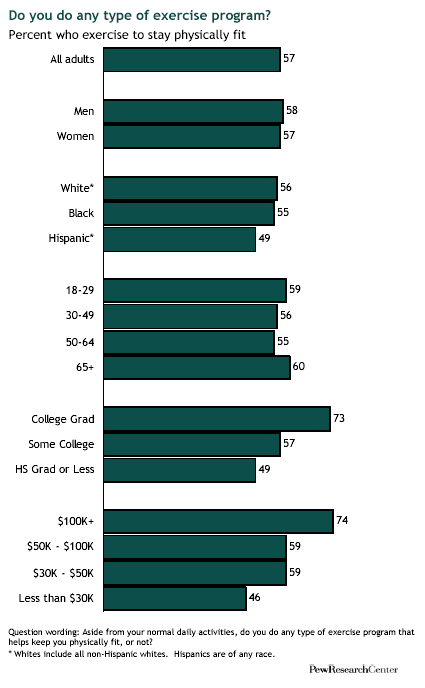
Americans are sold on the value of exercise. More than eight-in-ten (86%) believe exercising for fitness improves a person’s odds of a long and healthy life by “a lot.” And, about six-in-ten believe that exercising has “a lot” of impact on a person’s attractiveness. But just 28% report that they get as much physical exercise as they should. There is no demographic or weight classification group in which a majority feels they get as much exercise as they should.
Some 57% of Americans report that they do some type of exercise program to keep physically fit. Even among this group, however, just 34% say they’re getting as much exercise as they should while 65% think they should be getting more.
Those who are currently dieting are more likely than those not currently dieting to also be exercising. The overweight may need exercise more but they are less likely to be doing it compared with those who are about the right weight. About half (53%) of those who consider themselves overweight are exercising; the comparable figure among those who who consider their weight about right is 61%.
Both men and women, young and old are about equally likely to be exercising. Those with more education and higher incomes are more likely than their counterparts to take part in an exercise program. There are modest differences in exercising by race and ethnicity; Hispanics are less likely than non-Hispanic whites to exercise while blacks and whites are about equally likely to do so.
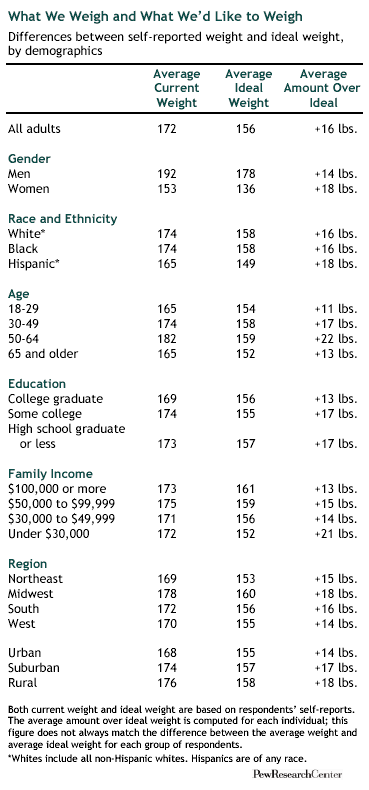
What keeps people out of the gym? One impediment to more physical activity may be the fun factor. There is a strong correlation between enjoyment of exercise and doing it. Among those who enjoy exercising a great deal, 85% take part in an exercise program; this figure drops to 68% among those who say they enjoy exercising “a fair amount” and to just 37% among those who are less enthusiastic about exercise.
Exercising is correlated with self-ratings of health and physical fitness. Seven-in-ten of those who rate their health as excellent say they have an exercise program. More than three quarters (77%) of those who rate their physical fitness as excellent have an exercise program and a majority of this group enjoys exercising “a great deal.” This is the only group in which a clear majority (62%) reports that they get about as much exercise as they should.
How much do we need to lose?
The Pew survey finds that Americans would like to be thinner than they are – on average, about 16 pounds thinner. Women would like to lose more weight than men; the average woman says she is 18 pounds above her ideal weight, while the average man says he is 14 pounds above his ideal weight. Also, the middle-aged would like to lose more weight than would either the young or the old.
There are some differences by education and income levels as well. College graduates say they have a little less weight to lose (13 pounds on average) than do those with less education. Also, those with lower incomes (under $30,000 a year) say they need to lose more weight (21 pounds on average) than do those in the middle and upper income brackets.
There are also some modest differences by where people live. Midwesterners put themselves at about 18 pounds over their ideal weight, while Westerners say they are an average of 14 pounds too heavy. Similarly, those in rural areas consider themselves an average of 18 pounds heavier than ideal, while suburbanites say they need to lose 17 pounds on average and urban residents say they need to lose 14 pounds.
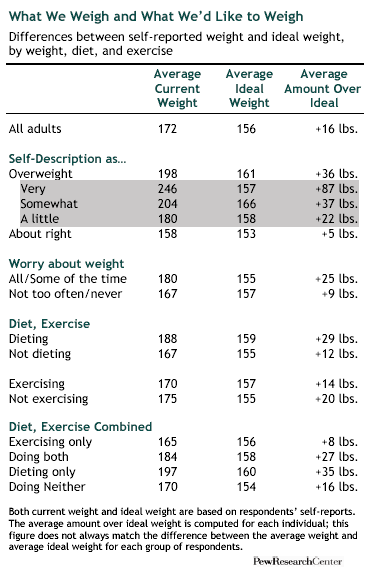
Not surprisingly, those who consider themselves very overweight would like to lose a lot more weight (87 pounds) than would those who consider their weight about right (5 pounds).
We computed these differences between actual weight and ideal weight by asking respondents first to state what they weigh and then to state what they considered their ideal weight. More than six-in-ten of the respondents (63%) gave a current weight that was heavier than their ideal weight, while 16 percent said both figures were the same and 12 percent said their ideal weight was greater than their current weight.
But while 63% said their actual weight was greater than their ideal weight, just 39% of adults in this same survey said, in response to a different question, that they considered themselves overweight.
The apparent explanation for this disparity is that almost a quarter (24%) of all adults say they are no more than 10 pounds over their ideal weight. And most of the people in this “near-ideal” group describe themselves as being just about the right weight rather than being overweight.
About the Survey
Results for this survey are based on telephone interviews conducted with a nationally representative sample of adults, ages 18 years and older, living in continental U.S. telephone households.
- Interviews conducted February 8- March 7, 2006
- 2,250 interviews
- Margin of sampling error is plus or minus 2.5 percentage points for results based on the total sample at the 95% confidence level. The margin of sampling error is higher for results based on subgroups of respondents.
Survey interviews conducted under the direction of Princeton Survey Research Associates International. Interviews were conducted in English and Spanish.
In addition to sampling error, bear in mind that question wording and practical difficulties in conducting surveys can introduce error or bias in the findings of opinion polls.
Read the full report for more details.




